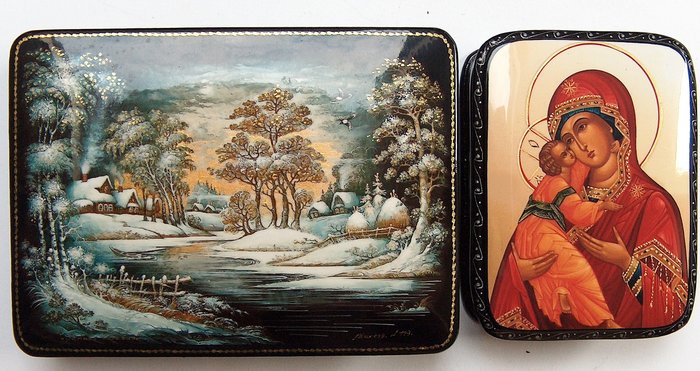No. 15915917

Russian 2 lacquer boxes - “Fedoskino” – “Winter Village” and “Palekh Miniature ”–“ Icons of the Mother of God”
No. 15915917

Russian 2 lacquer boxes - “Fedoskino” – “Winter Village” and “Palekh Miniature ”–“ Icons of the Mother of God”
Fedoskino - Dimensions: 150 mm x110 mm x 35 mm
Work artisan Михеев (Cyrillic) - digits - this master registration number.
„Palekh Miniatur: Dimensions: 10 cm x 8 cm x 3 cm
You can not subscribe to icons
perfect condition
Will be shipped registered and packaged carefully.
Fedoskino: the first production occurred in 1795 when a merchant PI Korobov organized in bought them Danilkovo hamlet (now part of the Fedoskina) „КОЗЫРЕЧНОЕ” (lacquered visors for food capsules) production - the production of lacquered army visors. Three years later Korobov visited the factory Johann Shtobvassera, in Braunschweig, there is adopted the technology products from papier-mache and started the production of its factory on top while snuff snuff, decorated with engravings pasted on the cover, sometimes painted and lacquered. In the second quarter of the XIX century, snuff, bisernitsy, boxes and other items were decorated with miniature paintings, executed in oils in the classical manner of painting.
Palekh: since the pre-Petrine times was famous for its icon painters. The greatest flourishing of Palekh iconography reached the XVIII - early XIX century. Local style was formed under the influence of Moscow, Novgorod, Stroganov and Yaroslavl schools. In addition to icon painting, the Paleshans were engaged in monumental painting, participating in the painting and restoration of churches and cathedrals, including the Faceted Chamber of the Moscow Kremlin, the temples of the Trinity-Sergius Lavra, the Novodevichy Monastery.
After the revolution of 1917 the painters of Palekh were forced to look for new forms of realizing their creative potential. In 1918 the artists created the Palekh Artistic Decorative Artel, which was engaged in painting on wood. The ancestors of the Palekh style are Ivan Golikov and Alexander Glazunov, in whose Moscow workshop Ivan Golikov wrote the first work in the so-called Palekh style. The Palesans got acquainted with the new material papier-mache, which for a century was the basis for the lacquer miniature Fedoskina. The masters mastered the new material, transferring to it the traditional for the ancient Russian icon-painting technology and conventional image stylistics. For the first time Palekh miniatures on papier-mache made at the request of the Handicraft Museum were presented at the All-Russian Agricultural and Artisanal Exhibition in 1923, where they were awarded diplomas of the 2 nd degree.
On December 5, 1924, the seven Palekh artists Ivan Golikov, Ivan Markichev, Ivan Bakanov, Ivan Zubkov, Alexander Zubkov, Alexander Kotukhin, and VV Kotukhin united in the Artel of Ancient Painting. Later they were joined by artists Ivan Vakurov, Dmitry Butorin, Nikolai Zinoviev. In 1925 Palekh miniatures were exhibited at the World Exhibition in Paris.
Typical plots of Palekh miniatures are borrowed from everyday life, literary works of classics, fairy tales, epics and songs. A number of compositions are based on the traditions of classical art [1]. Works are usually performed with tempera paints on a black background and painted with gold.
This object was featured in
How to buy on Catawiki
1. Discover something special
2. Place the top bid
3. Make a secure payment
